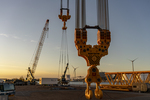News Release from National Renewable Energy Laboratory
Wind Industry Profile of
New Data Sound Good for Wind Energy
“It’s kind of soothing, actually,” said Hamilton, a research engineer at the National Renewable Energy Laboratory (NREL). “It’s easy to forget you’re listening to data. It’s a little like white noise.”
But those sounds are anything but white noise: They are the foundation of the most comprehensive dataset on exactly how quiet modern land-based wind plants could get.
Wind energy is one of the fastest growing—and cheapest—renewable energy sources in the United States. To meet the Biden-Harris administration’s goal of net zero emissions by 2050, the industry must grow to between five and 10 times its current size. But while this growth could decrease carbon emissions and energy prices, and create jobs, too, it could also bring wind plants closer to residential neighborhoods.
And because modern wind farms are using new operational strategies to increase energy production—strategies that could also increase noise production—potential noise might block new projects, limiting the growth of this cost-effective source of clean energy.
Current turbines are sited far enough from homes that perceptible noise is minimal (a nearby wind plant is no louder than a refrigerator heard from another room). But today, wind plant owners and wind turbine manufacturers are using a new technique to increase the performance of wind plants as a whole: wake steering. Wakes are regions where winds slow behind a wind turbine, which can decrease energy production of downwind turbines. By yawing wind turbines—turning them to face the wind at slightly different angles—wind plant operators can steer wakes, decreasing energy production for specific turbines but increasing production for the entire wind plant. Before yawing becomes the go-to technique for plants, wind plant developers need to know if it increases (or decreases) noise.
“Given public concerns about wind turbine noise,” Hamilton said, “we must understand how wake steering could impact acoustic emissions. Regulators will also need observational data to establish noise restrictions.”
To gather that data, Hamilton and his colleagues at NREL’s Flatirons Campus strategically placed 11 microphones beneath a U.S. Department of Energy-owned 1.5-megawatt wind turbine made by General Electric. The microphones collected noise across the entire range of frequencies that humans can perceive. They also captured “full-field data,” Hamilton said, to measure how noise fluctuates across a large area.
Their results were surprising.
Acoustic emission models predicted that wind turbines with yaw offsets would increase noise. But the team’s data show the opposite: Yawed operation reduced wind turbine noise.
Though the decrease is slight, any noise reduction is a win: “If you can decrease the noise production of a wind turbine, you can open new wind turbine design opportunities,” Hamilton said. “For example, rotors that produce less noise could operate at a higher speed. At a higher speed, they can use a lighter gearbox to produce the same energy, decreasing the cost of a turbine.”
This was, Hamilton continued, “a surprising result. But a happy one.” The data show that if a wind plant uses wake steering, it can both create more energy as a whole and potentially decrease noise at the same time.
So, why were the acoustic models so wrong? "We used the noise models to measure an entirely new problem (yawed turbines),” Hamilton said, “which they weren’t originally intended to study.” That could explain why the experimental results were so surprising. It also shows the models could use another look. Future models should adapt to analyze the impacts of modern techniques that wind plant operators use to control how much energy their turbines generate.
Hamilton and his team’s novel noise measurement capabilities are available in a recent technical report and an open-source, DOE-hosted dataset. His techniques can be adapted to study more noise-related questions for current and future wind farms. At NREL, researchers may soon use the team’s methods to study the acoustics of not just one turbine but an entire wind plant, offshore wind plants, highly flexible turbine blades, new turbine blade shapes, and even how hills and other landscape features might interact with nearby turbines.
“There’s a lot of opportunity for us to continue using this equipment and making more measurements,” Hamilton said.
That means he might have hundreds more hours of wind to listen to very soon.
- Source:
- NREL
- Author:
- Press Office
- Link:
- www.nrel.gov/...
- Keywords:
- NREL, research, noise, wind, wind farm, onshore, white noise, data, turbine, emissions, plant, wake steering, yawning


























